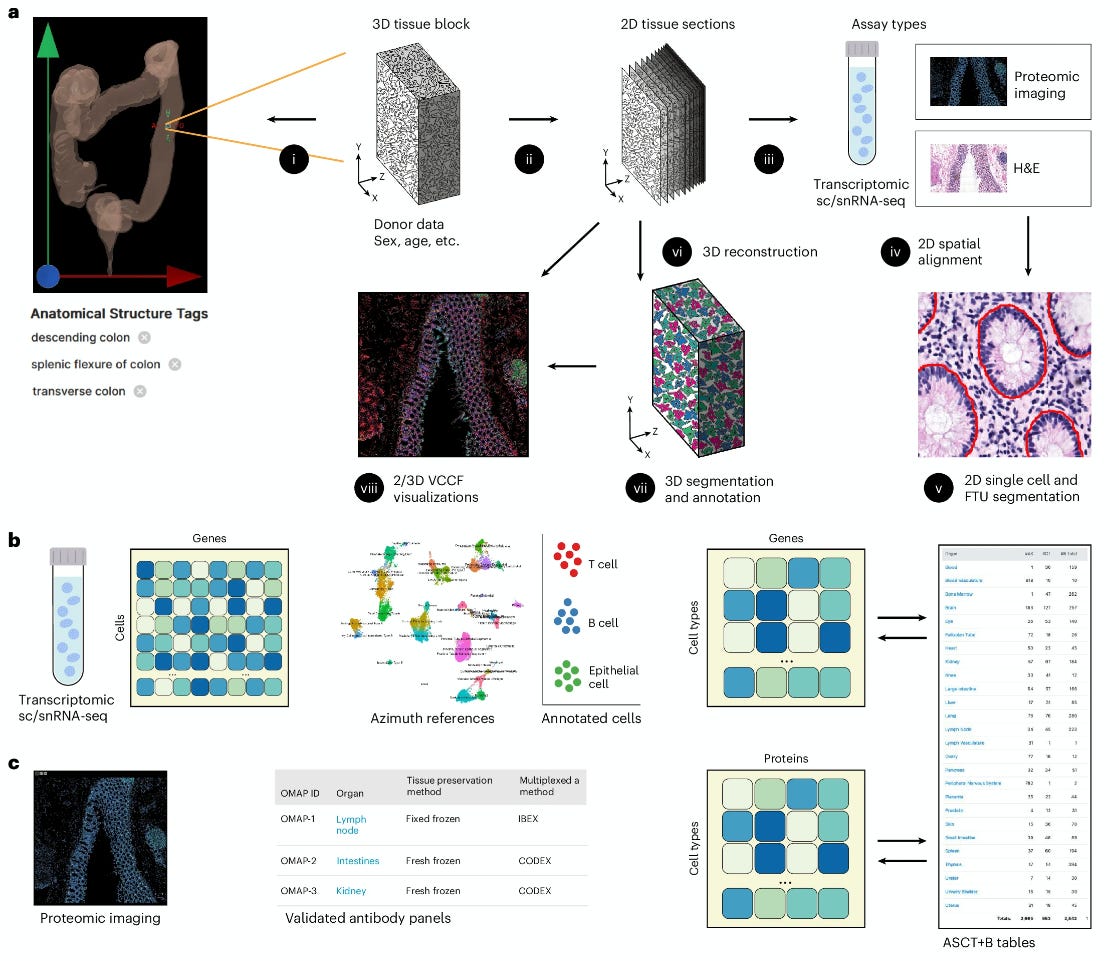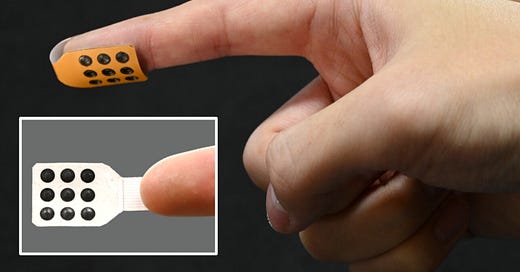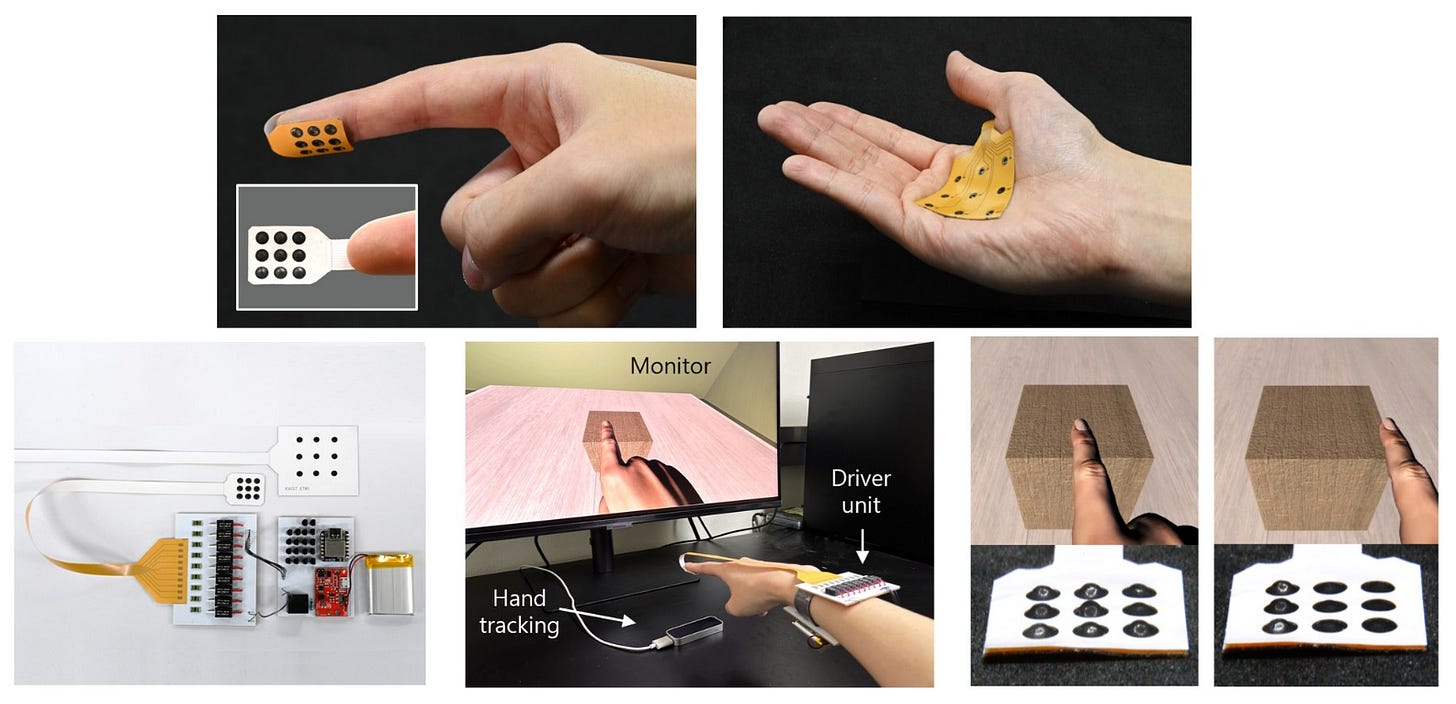Weekly Tech+Bio Highlights #34
Recent Histology Foundation Model, Agentic AI's, Bringing Touch to VR, and more...
Hi! This is
’s weekly newsletter, Where Tech Meets Bio, where we explore technologies, breakthroughs, and cutting-edge companies.If this newsletter is in your inbox, it’s because you subscribed or someone thought you might enjoy it. In either case, you can subscribe directly by clicking this button:
Let’s get to this week’s topics!
🤖 AI x Bio
(AI applications in drug discovery, biotech, and healthcare)
🔹 AI predicting drug interactions before trials begin—a multimodal model from Harvard researchers, supported by AstraZeneca among others, screened 21,842 compounds and outperformed state-of-the-art methods across 953 clinical outcomes.
🔹 A new foundation model is bringing scale to histology—Bioptimus has released H-Optimus-1, trained on over 1 million whole-slide images from 800,000+ patients across 50+ organ tissues, making it the largest histopathology model to date. Designed for biomarker discovery, patient stratification, and AI-assisted diagnostics. Available on Hugging Face.
🔹 As AI agents evolve from tools into autonomous actors, IBM’s AI Ethics Board releases a new report outlining the compounding risks of letting AI systems learn, reason, and act independently—highlighting threats like goal misalignment, black-box decision-making, and cascading errors, and urging industry to move beyond prompt engineering toward robust, intent-driven governance. Shared by Andreas Horn, Head of AIOps at IBM.
🔹 An open science challenge is putting ML drug discovery tools to the test—as part of the Target 2035 initiative, the Structural Genomics Consortium and partners launched a DREAM Challenge inviting researchers to predict active compounds from DNA-encoded library data.
🔹 Harvard researchers launch TxAgent, an AI system for therapeutic reasoning that integrates 211 biomedical tools to generate safe, evidence-based treatment plans.
🔹 Oxford Nanoimaging launches its ML-powered lipid nanoparticle profiler kit to automate single-particle analysis of LNPs, using super-resolution microscopy and software to quantify size, payload, and ligand distribution
🔹 Stanford and Cornell researchers created MorphLDM, a new AI model that builds detailed 3D brain MRIs by learning and reshaping anatomical templates—making the images far more realistic and improving brain structure accuracy and age prediction.
🔹 A new model, ProtComposer, gives researchers more control over how proteins are shaped in 3D by using ellipsoids to guide design—letting AI generate complex, modular protein structures that align more closely with natural biology and even editable by layout.
🔹 Causaly debuts agentic AI in its biomedical research platform, enabling drug discovery teams to synthesize insights across internal data and vast scientific literature—allegedly cutting weeks of target validation down to minutes, with full traceability across 500M facts and 70M relationships.
🔹 AI scribes are easing clinician burnout and improving work-life balance—some hospitals report up to 63% reduction—but early data shows limited clarity on their financial return, with adoption still uneven across providers, reports Peterson Health Technology Institute.
🔹 Talkspace rolls out Talkcast, an AI-powered tool letting therapists create short, personalized podcast episodes to reinforce therapy between sessions.
🚜 Market Movers
(News from established pharma and tech giants)
🔹 Pfizer teams up with Flagship Pioneering’s drug unit and the AI-powered Logica platform from Valo Health and Charles River to discover novel small molecule inhibitors for autoimmune diseases—marking the sixth R&D collaboration under their strategic partnership to fast-track next-gen therapies.
🔹 A 185-year-old company seca debuts real-time body composition tracker for GLP-1 patients—the tracker integrates fat, muscle, and weight data with clinical plans, aiming to help providers personalize therapy adjustments and preserve muscle mass during rapid weight loss interventions.
🔹 NVIDIA expands its healthcare plans, unveiling new partnerships at GTC 2025 with GE HealthCare, Moon Surgical, and others to simulate and train robotic imaging systems
💰 Money Flows
(Funding rounds, IPOs, and M&A for startups and smaller companies)
🔹 Isomorphic Labs raises $600M to scale its AlphaFold-powered AI drug design platform—the company will advance its in-house oncology and immunology programs and deepen pharma partnerships.
🔹 Aqemia lands $7.4M to tackle RNA drug targets with physics-driven generative AI—expanding beyond proteins, the Paris-based startup will apply its simulation-based platform to model RNA’s complex dynamics, supported by the France 2030 plan.
🔹 Constructive Bio raises $58M to reprogram the genetic code for greener drug production—backed by LongeVC and others, the UK biotech uses engineered E. coli to biosynthesize therapeutic peptides like GLP-1 analogues, replacing waste-heavy solid-phase synthesis.
🔹 Turn Bio acquires Vesigen’s ARMMs delivery tech to supercharge epigenetic reprogramming therapies—the microvesicle system, licensed from Harvard, enables targeted delivery of complex cargo like gene editors and RNAs to tissues such as retina, liver, and immune cells
🔹 AIRNA raises $155M in Series B to launch clinical trials of its RNA editor targeting alpha-1 antitrypsin deficiency, aiming to correct the disease-driving mutation without altering DNA.
🔹 Epicrispr Biotechnologies raises $68M Series B to launch the first human trial of the one-time gene-silencing therapy for a common form of muscular dystrophy, with trials set to begin in New Zealand.
🔹 Character Biosciences raises $93M Series B to bring its precision therapies for age-related macular degeneration into clinical trials, using a massive dataset of genetic and imaging profiles from over 6,500 patients to redefine subtypes of vision loss and target them with genomics-informed drug candidates.
🔹 Hillstar Bio raises $67M Series A to bring a precision therapy for inflammatory back and joint disease into trials, using a novel strategy that selectively depletes harmful immune cells—offering the potential to reset the immune system without broad immunosuppression.
⚙️ Other Tech
(Innovations across quantum computing, BCIs, gene editing, and more)
🔹 A brain implant now turns thoughts into speech in real time—researchers developed a BCI+AI system that streams natural speech at 47–90 words per minute using deep learning and 253 cortical electrodes. Published in Nature Neuroscience, the system reconstructed a participant’s voice using audio from her wedding video, marking a leap in restoring communication for people with paralysis. (link for image)
🔹 Virtual touch just got real—Korean researchers have developed a thin, flexible skin-attached haptic patch that enables real-time tactile communication and 3D texture rendering in AR/VR. Published in Science Advances.
🔹 A busy week for gene editing developments, by Spencer Knight—Epicrispr raised $68M to advance its CRISPR-based epigenetic therapy for FSHD; Precision BioSciences received FDA clearance to begin trials for hepatitis B; iECURE reported a complete clinical response in the first infant treated for OTC deficiency; Intellia’s ATTR therapy gained Fast Track and RMAT status; Verve got U.S. trial clearance for its PCSK9 base editor; and AccurEdit received Orphan Drug Designation for its LNP-based therapy.
🔹 A new way to see inside the ear without surgery—Waseda University-led researchers used terahertz (THz) imaging to non-invasively visualize and reconstruct 3D cochlear structures in mice, offering a potential diagnostic tool for hearing loss and beyond.
This newsletter reaches over 8.3K industry professionals from leading organizations across the globe. Interested in sponsoring?
Contact us at info@biopharmatrend.com
Multimodal Human Reference Atlas
The Human BioMolecular Atlas Program (HuBMAP) has recently released a comprehensive 3D Human Reference Atlas (HRA) of the healthy adult body, as detailed in Nature Methods (2025). The HRA v.2.0 now catalogs thousands of anatomical structures, cell types, and biomarkers, delivering a detailed multiscale map that spans from whole organs down to individual cells and molecular markers.

To construct the reference atlas, the researchers combined expert-generated data with recent experimental findings. They organized information from various sources using ASCT+B tables, along with 2D and 3D reference objects and detailed ontology mappings. New experimental data can be integrated using cell type annotation tools, tested antibody panels, and spatial registration methods.
The HRA is designed to serve as a canonical reference for understanding biological variation across individuals and throughout different life stages, including changes related to aging and disease. By promoting close collaboration among academic, governmental, and industrial partners, HuBMAP aims to provide researchers with a powerful resource for advanced data integration, visualization, and analysis.
AI for Pandemic Preparedness
AI is being reimagined as a tool for pandemic preparedness—in Nature perspective, researchers from Institut Pasteur, University of Oxford, and University of Copenhagen argue that AI could enhance epidemic modeling, pinpoint high-risk zones, and speed vaccine development by integrating population-scale and individual health data.
While previous AI applications in medicine have focused on individual patient care, this study shifts the focus to population health. The researchers highlight that improved disease propagation models, enhanced genetic surveillance, and targeted resource allocation could accelerate vaccine development and early identification of new variants. They advocate for rigorous data sharing and transparent modeling to maximize these benefits.
Key figures such as Prof. Moritz Kraemer, Prof. Eric Topol, and Samir Bhatt stress the need for close collaboration between academic, governmental, and industrial sectors. They call for strict evaluation criteria, robust human oversight, and ethical governance frameworks to ensure that the transformative potential of AI is harnessed safely and responsibly.
Bringing Touch to VR
Jung-Hwan Youn and his colleagues have presented a skin-attached haptic patch, detailed in Science Advances, that aims to bring the sense of touch into virtual and augmented reality. Their goal was to move beyond the usual visual and auditory cues and create a device that truly lets users feel digital environments.
They built a patch that’s both lightweight and flexible, using a dense array of tiny actuators integrated with sensors and a compact control circuit. These actuators are made from layered elastomer materials paired with a carefully designed compression spring, which cleverly converts slight material expansion into noticeable movement. This design allows the patch to deliver everything from steady pressure to dynamic vibrations over a wide frequency range, all while fitting snugly against the skin.
The team put the patch through rigorous tests to see how well it could mimic various tactile sensations, such as the contours of a shape or the texture of a surface. They measured factors like movement range, force, and response speed to ensure that the sensations would be easily felt by users on different parts of the body. By adding tactile sensors, the patch can both send and receive touch information in real time, paving the way for interactive, two-way tactile communication.





